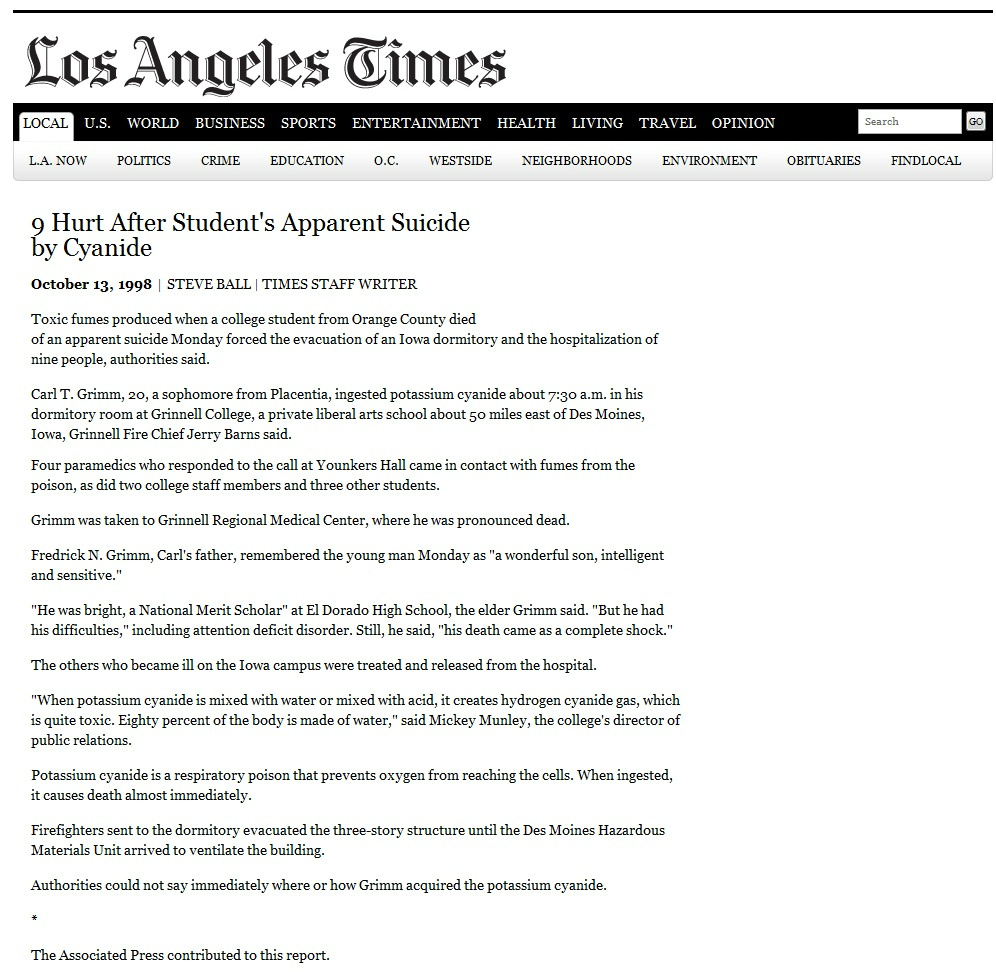
But David Olère, despite working as a sonderkommando for 2 years, died aged 83 in 1985. Filip Müller spent
Plain Dealer, The (Cleveland, OH)
December 19, 1999
Section: NATIONAL
Edition: FINAL / ALL
Page: 30A
IDAHO HEARING TO PONDER A MAN'S LIFE TRASHED IN CYANIDE TANK
TOM KENWORTHY WASHINGTON POST
At the age of 23, most young men's lives stretch out ahead of them. For Scott Dominguez, his life is largely in the past.
Three years ago, while working at Evergreen Resources, a ramshackle industrial chemical reprocessing plant in his small home town of Soda Springs, Idaho, Dominguez climbed down into a 25,000-gallon steel tank and, at the direction of his employer, began cleaning out the sludge at the bottom. The Scott Dominguez who was hauled out of the tank an hour later by fire department rescue crews would never be the same as the Scott Dominguez who went in, a vital young man fond of skiing, hunting and baseball.
The 36-foot-long tank into which Dominguez descended that day had once held cyanide. Later, it had held phosphoric acid. The combination, worsened when Dominguez began chipping away at it and hosing it down with water, produced hydrogen cyanide gas, the same lethal chemical used by Nazi Germany to gas Jews at Auschwitz.
Working without any safety equipment, Dominguez was overcome and, despite the frantic efforts of co-workers, could not be carried up a ladder out of the tank. Firefighters eventually cut a hole in the side and pulled him free.
Today, Dominguez still has the ready smile for which he was known before his accident. But it is sometimes frozen on his face by the brain damage he suffered. Dominguez talks with great difficulty, struggling to utter a simple yes or no.
Both his fine and gross motor skills are severely impaired. To shower, shave and brush his teeth in the morning is sometimes a three-hour ordeal. At night, he is unable to roll over in his bed, and his mother often must assist him several times an hour. He can walk, but he often stumbles. When he lifts his spoon to his mouth, or tries to cast a fishing line as he used to, he gets "stuck," says his mother, Jackie Hamp.
For all his physical and mental difficulties, Dominguez is aware of what happened to him. He knows he will never get well. And he knows who is responsible for imprisoning his mind and weakening his body. When he is asked about these things, tears well up and trickle down his cheeks.
Sometime next month, Dominguez will struggle up the steps of the U.S. courthouse in this southeast Idaho city to attend a sentencing hearing for Allan Elias, the owner of Evergreen Resources who last spring was convicted of violating a federal hazardous-waste law and of falsifying a worker safety permit.
It took the jury just five hours to find Elias guilty on four counts related to Dominguez's injury, despite the best efforts of a battery of high-powered defense lawyers. Federal prosecutors expect that Elias will be sentenced to the longest prison term ever imposed in an "environmental crime," perhaps 15 years or longer.
Over the last generation, the United States has erected a comprehensive legislative and regulatory safety net to prevent industrial accidents like the one that devastated Dominguez. The Resource Conservation and Recovery Act governs the handling and disposal of hazardous industrial chemicals.
The Occupational Safety and Health Administration (OSHA) regulates workplace safety.
According to state and federal regulators who testified at his trial, Elias paid little heed to those laws and regulations.
Both at Evergreen Resources, which manufactured fertilizer from the waste products of a nearby Kerr-McGee Corp. vanadium plant, and at a Pocatello facility he ran earlier that used a cyanide leaching system to wring silver from the waste created by a phosphorous plant, Elias was cited repeatedly for worker safety violations.
"We issued citations, and also monetary penalties," said Ryan Kuehmichel, the regional director for OSHA. "He told our inspectors from the very first time they went out that he knew all about cyanide and didn't need any of our help."
Though Elias, 61, did not testify in his own defense, his attorneys characterized what happened to Dominguez as a "freak accident" and insisted that Elias had tested the tank for cyanide and none had been detected. "He was substantially certain that he was not endangering" his workers, said defense attorney David Z. Nevin.
Prosecutors and the witnesses they called at trial told a far different story:
The only test Elias conducted on the sludge was to determine if it contained silver.
The only safety equipment he had on hand was a 40-year-old air pack that had a warning label stating it would not protect against cyanide.
His employees received no safety training for working in confined spaces.
He had no cyanide antidote kit on site.
He knew the tank had held cyanide at his previous business.
His employees had complained of feeling dizzy when working in the tank the day before the accident.
They had requested safety equipment, which he promised he would provide and never did.
After the accident, he backdated a confined space permit to meet OSHA regulations.
Rescue and medical personnel said Elias' failure to inform them what was in the tank delayed both the removal of Dominguez and prompt medical treatment. Daniel Teitelbaum, a Denver toxicologist, said that if Dominguez had been removed more quickly and administered a high volume of oxygen, it "would have substantially reduced the brain damage which occurred."
Had a cyanide antidote kit been nearby - one was eventually flown in from Pocatello - it would have "substantially improved the prognosis and reduced the likelihood of permanent brain damage," Teitelbaum testified.
Los Angeles Times9 Hurt After Student's Apparent Suicide by Cyanide
October 13, 1998
Toxic fumes produced when a college student from Orange County died of an apparent suicide Monday forced the evacuation of an Iowa dormitory and the hospitalization of nine people, authorities said.
Carl T. Grimm, 20, a sophomore from Placentia, ingested potassium cyanide about 7:30 a.m. in his dormitory room at Grinnell College, a private liberal arts school about 50 miles east of Des Moines, Iowa, Grinnell Fire Chief Jerry Barns said.
Four paramedics who responded to the call at Younkers Hall came in contact with fumes from the poison, as did two college staff members and three other students.
Grimm was taken to Grinnell Regional Medical Center, where he was pronounced dead.
Fredrick N. Grimm, Carl's father, remembered the young man Monday as "a wonderful son, intelligent and sensitive."
"He was bright, a National Merit Scholar" at El Dorado High School, the elder Grimm said. "But he had his difficulties," including attention deficit disorder. Still, he said, "his death came as a complete shock."
The others who became ill on the Iowa campus were treated and released from the hospital.
"When potassium cyanide is mixed with water or mixed with acid, it creates hydrogen cyanide gas, which is quite toxic. Eighty percent of the body is made of water," said Mickey Munley, the college's director of public relations.
Potassium cyanide is a respiratory poison that prevents oxygen from reaching the cells. When ingested, it causes death almost immediately.
Firefighters sent to the dormitory evacuated the three-story structure until the Des Moines Hazardous Materials Unit arrived to ventilate the building.
Authorities could not say immediately where or how Grimm acquired the potassium cyanide.
*
The Associated Press contributed to this report.




































